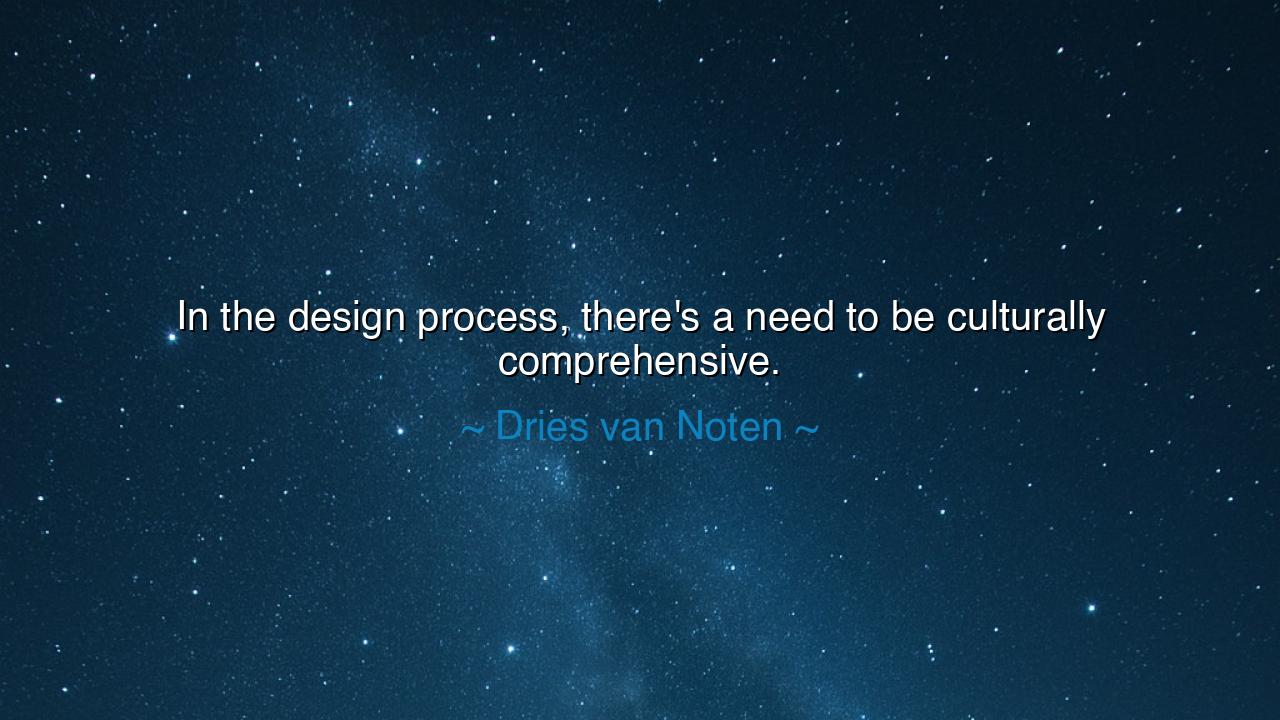
In the design process, there's a need to be culturally






“In the design process, there’s a need to be culturally comprehensive.” — Dries van Noten
In these thoughtful and resonant words, Dries van Noten, the masterful Belgian fashion designer, speaks to a truth that extends far beyond the realm of garments — a truth about understanding, inclusion, and respect. When he says there is a “need to be culturally comprehensive,” he is not merely talking about inspiration or aesthetics. He is speaking of the soul of creation — of the duty every artist, every thinker, every builder of the future bears: to see the world not through the narrow eyes of the self, but through the vast and varied lens of humanity. For in design, as in life, nothing grows in isolation. Every idea is born of countless roots — of history, of tradition, of place, of people. To create without awareness of this is not creation at all; it is imitation without spirit.
Dries van Noten, whose career blossomed from the avant-garde movement known as the Antwerp Six, became known for weaving global influences into his work — patterns from Asia, textiles from Africa, silhouettes inspired by both East and West. Yet his designs were never mere appropriation; they were homages — reflections of his belief that culture is a living dialogue, not a possession. His words arise from a lifetime of observing how beauty, when drawn from many sources with humility and understanding, can transcend boundaries and speak a universal language. Thus, when he speaks of being “culturally comprehensive,” he is calling us not to consume cultures, but to learn from them, to honor their wisdom, and to let them enrich our own visions of the world.
The ancients understood this principle long before our modern age of global exchange. The Greeks, though proud of their philosophy, learned astronomy and mathematics from Egypt and Babylon. The Romans, mighty in empire, borrowed their gods, their laws, and their art from the lands they conquered. The Islamic scholars of the Golden Age preserved and expanded upon Greek philosophy and Indian science, gifting them back to Europe centuries later. The history of human progress is not the story of one people, but of many voices woven into one great tapestry. To be culturally comprehensive, as Van Noten urges, is to recognize that no idea stands alone — every thought carries within it the echoes of the world.
But the designer’s wisdom is also a moral call. For too often, in the rush of creation, the modern world forgets the respect owed to origins. We borrow symbols, patterns, words, and ideas, but strip them of meaning. Van Noten’s statement, then, is not only about creativity — it is about responsibility. To be culturally comprehensive means to understand the story behind what we use, to honor the people who gave it birth, to remember that every design, whether of fabric, technology, or policy, touches human lives. In his words is the warning that beauty created without conscience becomes exploitation, but beauty created with awareness becomes connection.
Consider the story of Isamu Noguchi, the Japanese-American sculptor who sought to unite East and West in his art. Living between two worlds, he refused to belong to one alone. His sculptures blended the serenity of Zen with the modernist strength of the West; his lamps — the famous Akari — combined traditional Japanese paper lanterns with contemporary forms. Noguchi’s genius lay not in invention alone, but in synthesis — in his deep reverence for the cultural spirit that flowed through each material he touched. Like Van Noten, he saw creation not as self-expression, but as cultural communion — a way to bring humanity closer to itself.
The phrase “design process” that Van Noten uses may sound technical, but in truth it mirrors the process of life. For all human beings are designers — of homes, of relationships, of meaning. To live well, as to design well, we must be comprehensive: we must open ourselves to the wisdom of others, the beauty of diversity, the lessons of both past and present. Every encounter, every story, every tradition we meet can become a thread in the pattern of our understanding. The wise creator — whether artist, teacher, or leader — is not one who knows everything, but one who listens deeply, absorbs widely, and gives back with gratitude.
Lesson:
From Dries van Noten’s insight, we learn that true creation springs not from isolation, but from connection. To be culturally comprehensive is to live with open eyes and open heart — to see the unity within diversity, and to let that awareness guide our hands. In your own life, do not design only for yourself. Look outward, learn from the world, and let what you create — whether words, works, or deeds — reflect the vastness of the human experience. Honor what you borrow. Credit what you learn. Give back what you take. For the greatest designs, like the greatest lives, are those that embrace the full spectrum of humanity — woven from many colors, yet shining as one.






AAdministratorAdministrator
Welcome, honored guests. Please leave a comment, we will respond soon